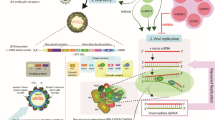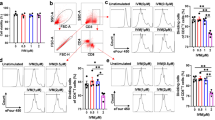Abstract
Purpose
Encephalitozoon intestinalis affects many physiological processes of host cells to survive, proliferate, and spread to different regions within the body. In this study, the effects of the parasite on host cell apoptosis and proliferation were investigated.
Methods
To determine the impact of the parasite on the host cell apoptosis, changes in the expression profile of genes were investigated with the qPCR array using the Human Apoptosis Panel in infected and non-infected macrophage cells. Also, the rate of apoptosis in the cells was determined by Giemsa staining method. Cell proliferation was determined by measuring the DNA concentration in infected and non-infected cells.
Results
The thirty-six of apoptosis-related genes were down-regulated, while 20 of apoptosis-related genes were up-regulated in infected cells compared to uninfected cells. However, there were no significant changes detected in 32 analyzed genes between infected and control groups. E. intestinalis was determined to decrease cell proliferation in U937 macrophage cells. Unexpectedly, Giemsa staining showed an increase in the rate of apoptosis in infected cells.
Conclusion
Regulated genes after infection are involved in many different biological pathways and various components of the cell. This suggests that the parasite uses highly sophisticated ways to maintain the viability of the cell.




Similar content being viewed by others
References
Anane S, Attouchi H (2010) Microsporidiosis: epidemiology, clinical data and therapy. Gastroenterol Clin Biol 34(8–9):450–464. https://doi.org/10.1016/j.gcb.2010.07.003
Cetinkaya Ü, Hamamcı B, Kaynar L, Kuk S, Şahin İ, Yazar S (2015) Investigation of the presence of Encephalitozoon intestinalis and Enterocytozoonbieneusi in bone marrow transplant patients by IFA-MAbs method. Mikrobiyol Bul 49(3):432–438. https://doi.org/10.5578/mb.9809
Hamamcı B, Çetinkaya Ü, Berk V, Kaynar L, Kuk S, Yazar S (2015) Prevalence of Encephalitozoon intestinalis and Enterocytozoonbieneusi in cancer patients under chemotherapy. Mikrobiyol Bul 49(1):105–113. https://doi.org/10.5578/mb.8787
Oğuz Kaya İ, Doğruman Al F, Mumcuoğlu İ (2018) Investigation of Microsporidia prevalence with calcofluor white and uvitex 2B chemiluminescence staining methods and molecular analysis of species in diarrheal patients. Mikrobiyoloji Bül 52:401–412. https://doi.org/10.5578/mb.67363
Curry A (2005) Microsporidiosis. In: Cox FEG, Wakelin D, Gillespie SH, Despommier DD (eds) Topley and Wilson’s Microbiology and Microbial Infections; Parasitology, 10th edn. ASM press, Washington, D.C., pp 529–555
Franzen C (2005) How do microsporidia invade cells? Folia Parasitol (Praha) 52(1–2):36–40. https://doi.org/10.14411/fp.2005.005
Fasshauer V, Gross U, Bohne W (2005) The parasitophorous vacuole membrane of Encephalitozoon cuniculi lacks host cell membrane proteins immediately after invasion. Eukaryot Cell 4(1):221–224. https://doi.org/10.1128/EC.4.1.221-224.2005
del Aguila C, Izquierdo F, Granja AG, Hurtado C, Fenoy S, Fresno M, Revilla Y (2006) Encephalitozoon microsporidia modulates p53-mediated apoptosis in infected cells. Int J Parasitol 36:869–876. https://doi.org/10.1016/j.ijpara.2006.04.002
Scanlon M, Shaw AP, Zhou CJ, Visvesvara GS, Leitch GJ (2000) Infection by microsporidia disrupts the host cell cycle. J Eukaryot Microbiol 47:525–531. https://doi.org/10.1111/j.1550-7408.2000.tb00085.x
Elmore S (2007) Apoptosis: a review of programmed cell death. Toxicol Pathol 35:495–516. https://doi.org/10.1080/01926230701320337
Reed JC (2000) Mechanisms of apoptosis. Am J Pathol 157(5):1415–1430. https://doi.org/10.1016/S0002-9440(10)64779-7
Cetinkaya U, Charyyeva A, Gurbuz E (2018) Evaluation of the reproductive potential of Encephalitozoon intestinalis in four different cell line. Mikrobiyol Bul 52(4):390–400. https://doi.org/10.5578/mb.67383
Ovalle-Bracho C, Franco-Muñoz C, Londoño-Barbosa D, Restrepo-Montoya D, Clavijo-Ramírez C (2015) Changes in macrophage gene expression associated with Leishmania (Viannia) braziliensis infection. PLoS ONE 10(6):e0128934. https://doi.org/10.1371/journal.pone.0128934
Sokolova YY, Bowers LC, Alvarez X, Didier ES (2019) Encephalitozoon cuniculi and Vittaforma corneae (Phylum Microsporidia) inhibit staurosporine-induced apoptosis in human THP-1 macrophages in vitro. Parasitology 146(5):569–579. https://doi.org/10.1017/S0031182018001968
Hofland LJ, van Koetsveld PM, Lamberts SW (1990) Percoll density gradient centrifugation of rat pituitary tumor cells: a study of functional heterogeneity within and between tumors with respect to growth rates, prolactin production and responsiveness to the somatostatin analog SMS 201–995. Eur J Cancer 26(1):37–44. https://doi.org/10.1016/0277-5379(90)90254-q
Heussler VT, Kuenzi P, Rottenberg S (2001) Inhibition of apoptosis by intracellular protozoan parasites. Int J Parasitol 31:1166–1176. https://doi.org/10.1016/s0020-7519(01)00271-5
Higes M, Juarranz Á, Dias-Almeida J, Lucena S, Botías C, Meana A, García-Palencia P, Martín-Hernández R (2013) Apoptosis in the pathogenesis of Nosema ceranae (Microsporidia: Nosematidae) in honey bees (Apismellifera). Environ Microbiol Rep 5(4):530–536. https://doi.org/10.1111/1758-2229.12059
Knodler LA, Finlay BB (2001) Salmonella and apoptosis: to live or let die? Microbes infect 3:1321–1326. https://doi.org/10.1016/s1286-4579(01)01493-9
Johnstone RW, Ruefli AA, Lowe SW (2002) Apoptosis: a link between cancer genetics and chemotherapy. Cell 108:153–164. https://doi.org/10.1016/s0092-8674(02)00625-6
Cianciulli A, Porro C, Calvello R, Trotta T, Panaro MA (2018) Resistance to apoptosis in Leishmania infantum-infected human macrophages: a critical role for anti-apoptotic Bcl-2 protein and cellular IAP1/2. Clin Exp Med 18(2):251–261. https://doi.org/10.1007/s10238-017-0482-1
Johnstone RW, Frew AJ, Smyth MJ (2008) The TRAIL apoptotic pathway in cancer onset, progression and therapy. Nat Rev Cancer 8(10):782–798. https://doi.org/10.1038/nrc2465
Pitti RM, Marsters SA, Ruppert S, Donahue CJ, Moore A, Ashkenazi A (1996) Induction of apoptosis by Apo-2 ligand, a new member of the tumor necrosis factor cytokine family. J Biol Chem 271:12687–12690. https://doi.org/10.1074/jbc.271.22.12687
Fulda S, Meyer E, Debatin KM (2002) Inhibition of TRAIL-induced apoptosis by Bcl-2 overexpression. Oncogene 21(15):2283–2294. https://doi.org/10.1038/sj.onc.1205258
Acknowledgements
This study was financially supported by the Erciyes University Scientific Research Projects Unit, Kayseri, Turkey (No. TCD-2016-7042).
Author information
Authors and Affiliations
Contributions
UC, AC and ME designed the study and made the critical revision of the article. UC and MS performed the in vitro experiment. Collecting test data, drafting the article and getting a final approval of the version to be published were done by UC, ME and AC, as well as data analysis and interpretation was done by AC. In addition, UC and ME were responsible for supervision, and project administration.
Corresponding author
Ethics declarations
Conflict of Interest
The authors report no conflict of interest.
Additional information
Publisher's Note
Springer Nature remains neutral with regard to jurisdictional claims in published maps and institutional affiliations.
Rights and permissions
About this article
Cite this article
Çetinkaya, Ü., Caner, A., Charyyeva, A. et al. Encephalitozoon intestinalis Infection Impacts the Expression of Apoptosis-Related Genes in U937 Macrophage Cells. Acta Parasit. 66, 397–405 (2021). https://doi.org/10.1007/s11686-020-00288-x
Received:
Accepted:
Published:
Issue Date:
DOI: https://doi.org/10.1007/s11686-020-00288-x




